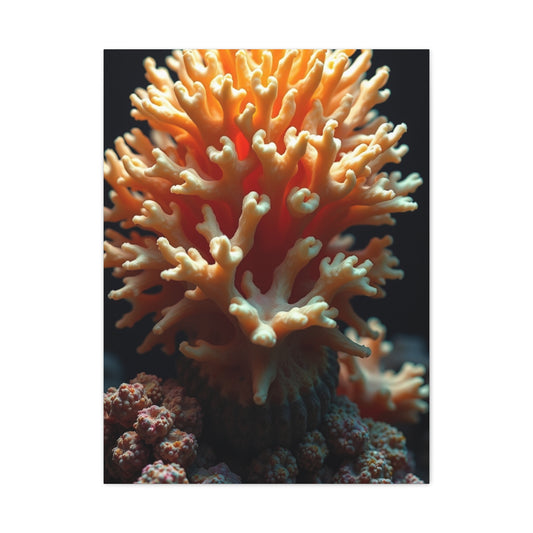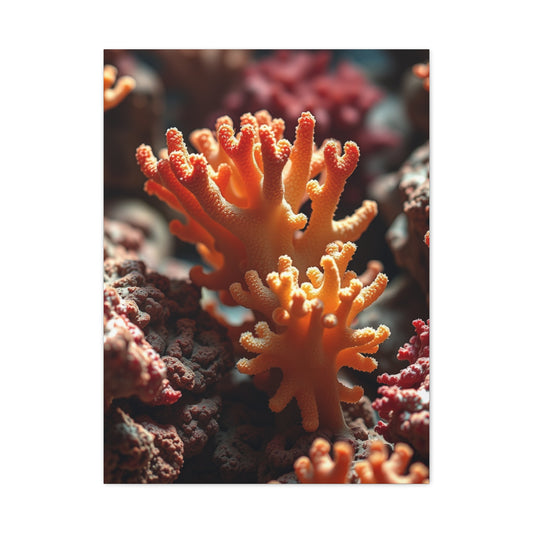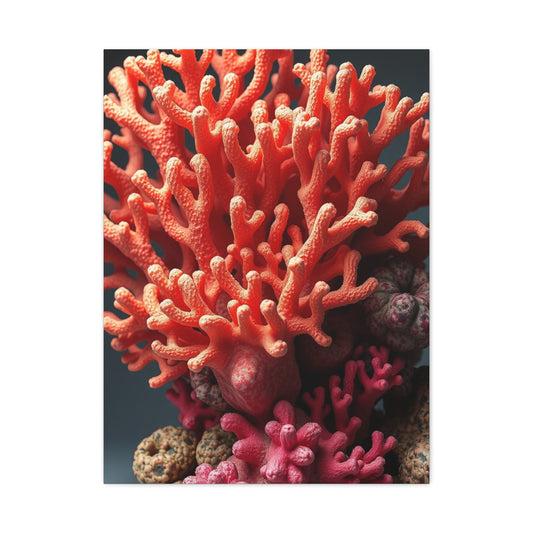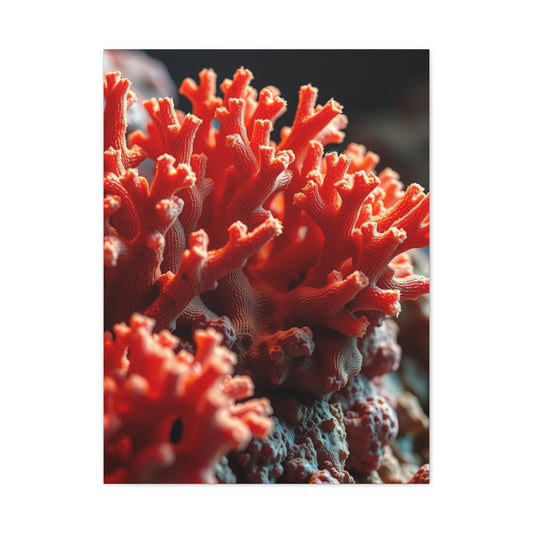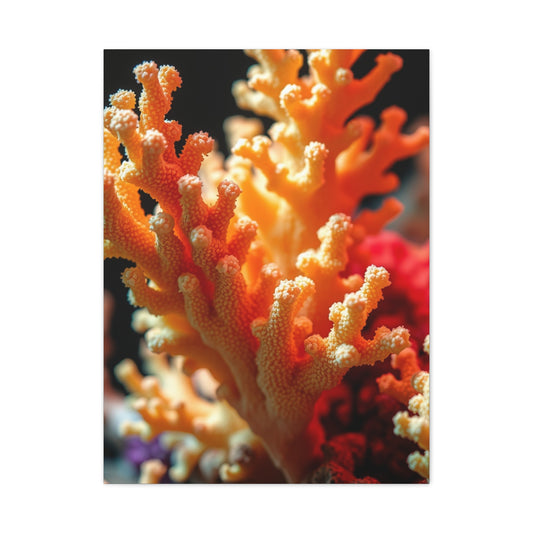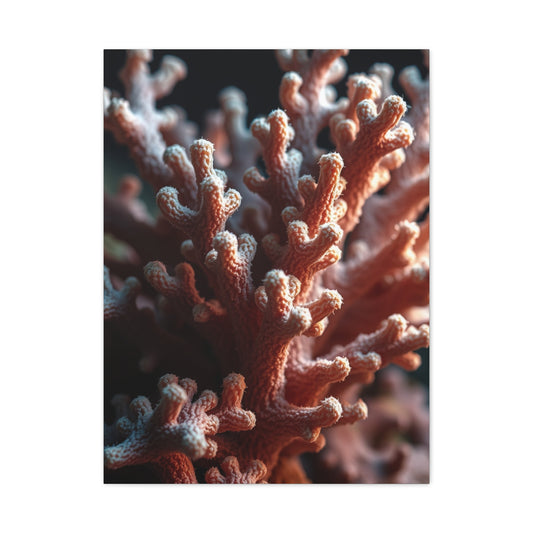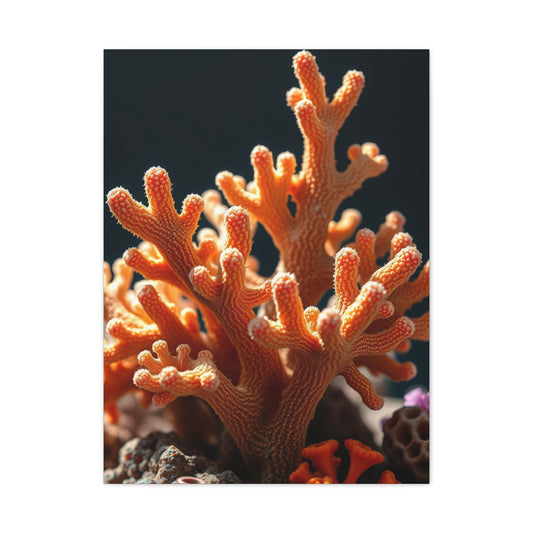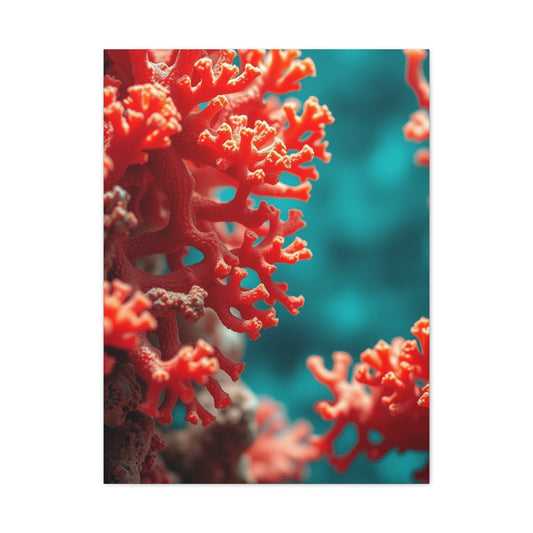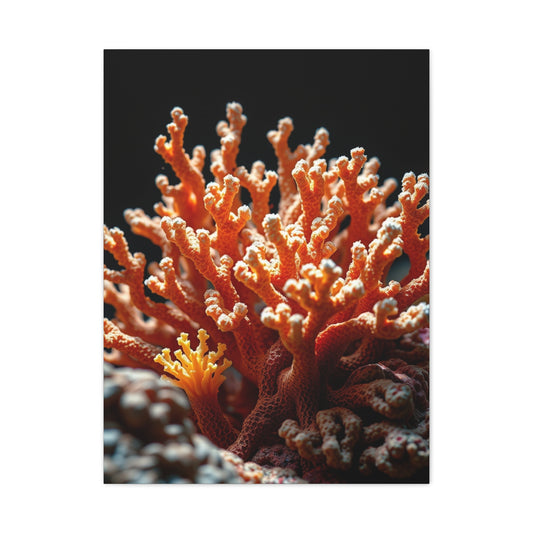Marine-Inspired Décor Revolution: The 2025 Coral Wall Art Movement
Contemporary interior design is witnessing an extraordinary transformation through coral-themed artistic expressions. This burgeoning movement transcends conventional decorative boundaries, establishing itself as a sophisticated design philosophy that harmonizes aesthetic excellence with environmental consciousness. The proliferation of coral-inspired artwork represents more than a fleeting decorative trend—it embodies a profound appreciation for marine biodiversity while addressing contemporary spatial needs.
The allure of coral artwork emanates from its capacity to infuse residential and commercial environments with organic dynamism. These artistic interpretations capture the mesmerizing complexity of underwater ecosystems, translating their inherent beauty into accessible visual narratives. Through innovative artistic techniques, creators are producing works that simultaneously celebrate marine magnificence and advocate for oceanic preservation, resulting in pieces that resonate deeply with environmentally conscious consumers.
The 2025 Coral Wall Art Movement marks a pivotal chapter in the evolution of modern interior design—one that fuses visual elegance with environmental awareness in ways that are both powerful and enduring. No longer limited to coastal homes or seaside resorts, marine-inspired décor has taken a bold and sophisticated turn, establishing coral-themed art as a central motif in contemporary living spaces. This movement is not merely about aesthetics; it is a conscious shift toward celebrating and protecting the fragile ecosystems that inspire these creations.
At the heart of this revolution lies coral artwork’s unique ability to bridge the natural and built environments. By bringing the textures, forms, and vivid hues of marine life into interiors, these pieces serve as a reminder of the ocean’s complex beauty and vulnerability. From intricate, hand-sculpted coral motifs to minimalist prints that echo reef patterns, each artwork captures the ethereal quality of the underwater world. This visual language not only elevates the design of a space but also stirs an emotional response—instilling a sense of wonder, tranquility, and, ultimately, responsibility.
The Coral Wall Art Movement is also redefining what it means to live sustainably. Many artists and designers leading this trend are committed to eco-conscious practices, using ethically sourced materials, non-toxic pigments, and even upcycled marine debris to craft their works. As a result, coral-inspired décor is becoming a form of environmental storytelling—inviting viewers to reflect on the impact of human activity on our oceans while appreciating the intrinsic value of marine biodiversity. In this way, each piece becomes more than decoration; it becomes advocacy.
Moreover, this trend offers a remarkable level of versatility across various interior styles. Whether integrated into a sleek, modern loft or a bohemian beach house, coral wall art adapts seamlessly. Soft, bleached tones of white coral evoke elegance and calm in minimalist settings, while vibrant interpretations in fiery reds and oranges inject energy into eclectic or tropical spaces. Large-scale coral sculptures make stunning focal points in grand entryways, while framed reef illustrations provide subtle charm in smaller, more intimate rooms.
The Coral Wall Art Movement also reflects a growing desire for designs that are emotionally resonant and deeply personal. As our global awareness expands, homeowners and designers alike are gravitating toward interiors that tell a meaningful story—one of interconnectedness, conservation, and conscious living. Coral, with its organic complexity and critical ecological role, symbolizes this narrative perfectly. Its visual representation becomes a metaphor for harmony, resilience, and the need to protect what is both beautiful and essential.
In a design world that often cycles through trends at breakneck speed, coral wall art offers lasting significance. It stands as a testament to the power of art to inspire change, to bridge cultural and environmental divides, and to transform living spaces into sanctuaries of both style and substance. As we move forward in 2025 and beyond, this marine-inspired décor revolution is not just about embracing the ocean’s beauty—it’s about embedding its message into the very walls that surround us.
Understanding the Fundamentals of Marine-Inspired Artistic Expression
Marine-inspired artistic expression, particularly coral-themed artwork, is a captivating intersection of science, aesthetics, and environmental consciousness. At its core, this form of artistic endeavor begins with careful and informed observation of the ocean’s natural forms—especially the intricate structures found within coral reef systems. Artists who explore this genre immerse themselves in the study of marine biology to better understand the anatomy, function, and ecological significance of coral formations. This scientific foundation allows them to translate these complex and delicate structures into visual compositions that are both accurate and emotionally evocative.
The foundation of coral-themed artwork rests on the artist’s ability to see beyond the surface—literally and metaphorically. Coral reefs are known for their labyrinthine patterns, diverse textures, and vibrant, shifting hues. These elements provide a rich visual language for artists to draw from. Through a wide variety of mediums—such as painting, sculpture, digital art, mixed media, and even textile design—artists interpret the branching forms, rhythmic growth patterns, and intricate surfaces of coral colonies. By doing so, they bridge the gap between marine science and human creativity, crafting works that celebrate the ocean while also drawing attention to its fragility.
Contemporary coral artwork spans a broad stylistic spectrum. On one end, there are hyperrealistic pieces that meticulously replicate specific coral species, capturing every ridge, polyp, and pigmentation with photographic precision. These works serve as visual documentation, often used for educational purposes or conservation campaigns. On the other end of the spectrum are abstract interpretations that focus less on literal depiction and more on conveying the feeling, movement, or essence of underwater life. These abstract pieces often emphasize color dynamics, flowing forms, or the emotive power of marine environments. Many artists combine both approaches—achieving a balance between realism and abstraction that allows for personal expression while maintaining a strong connection to the natural source.
One of the most critical aspects of executing effective coral-themed art lies in the use of color. Coral reefs are among the most color-rich ecosystems on the planet, displaying an incredible range of hues and subtle tonal shifts. Artists must possess a refined understanding of color theory to successfully capture this complexity. This includes an awareness of how light behaves underwater, how warm and cool tones interact, and how the colors of healthy versus bleached or damaged coral differ. Healthy corals radiate with neon-like blues, pinks, oranges, and purples, while bleached corals often appear stark white or ghostly grey—yet still hold a haunting beauty. Conveying these chromatic distinctions requires not only technical expertise but also emotional sensitivity.
Contemporary Chromatic Palettes and Thematic Developments
The 2025 coral art movement embraces an expansive spectrum of color philosophies and conceptual frameworks. Contemporary artists are moving beyond traditional representations, incorporating innovative approaches that reflect current environmental concerns while maintaining aesthetic appeal. This evolution has produced diverse artistic categories, each addressing different aspects of marine life and environmental consciousness.
Luminous Reef Interpretations
Contemporary coral artwork frequently explores the vibrant coloration of thriving marine ecosystems. These pieces emphasize the extraordinary diversity of reef coloration, from electric blues and emerald greens to passionate corals and golden yellows. Artists employ sophisticated layering techniques to achieve the depth and luminosity characteristic of underwater environments, creating works that seem to pulsate with life energy. These luminous interpretations serve as powerful reminders of what healthy reef systems represent and inspire viewers to consider their role in marine conservation.
Environmental Narrative Compositions
A significant portion of contemporary coral artwork incorporates storytelling elements that address environmental challenges facing marine ecosystems. These narrative compositions juxtapose images of flourishing reefs with subtle references to human impact, creating thought-provoking pieces that encourage environmental reflection without overwhelming viewers with explicit messaging. Artists achieve this balance through careful compositional choices, using symbolic elements and color transitions to convey complex environmental messages through purely visual means.
Monochromatic Coral Studies
The aesthetic appeal of bleached coral formations has inspired a sophisticated subcategory of minimalist coral artwork. These monochromatic studies utilize restricted color palettes dominated by whites, pale grays, and subtle blue undertones to create compositions of remarkable elegance and emotional depth. Despite their apparent simplicity, these works often convey profound messages about environmental fragility and the delicate balance required to maintain marine ecosystems.
Comprehensive Ecosystem Representations
Advanced coral artwork increasingly incorporates entire marine communities, depicting the complex relationships between coral formations and the diverse species they support. These comprehensive compositions showcase the intricate web of marine life, from microscopic organisms to larger fish species, creating dynamic artworks that celebrate biodiversity while educating viewers about ecological interconnectedness. These pieces often serve as centerpieces in educational settings and environmentally conscious homes.
Contemporary Abstract Reef Expressions
High-end interior spaces frequently feature abstract interpretations of coral formations that prioritize formal elements over literal representation. These sophisticated works capture the essential qualities of coral through fluid lines, organic shapes, and carefully orchestrated color relationships. Abstract coral artwork appeals to viewers who appreciate natural inspiration without requiring explicit representation, making these pieces particularly suitable for contemporary and minimalist interior design schemes.
Tactile Marine Installations
The growing emphasis on multisensory experiences has led to increased interest in three-dimensional coral artwork that engages viewers through texture and form. These tactile installations employ diverse materials including ceramics, textiles, metals, and synthetic compounds to recreate the physical qualities of coral formations. Viewers can appreciate these works through both visual observation and tactile exploration, creating deeper engagement with the subject matter.
Strategic Integration Approaches for Coral Artwork
Successfully incorporating coral artwork into existing interior design schemes requires careful consideration of spatial relationships, color harmonies, and stylistic coherence. The most effective implementations consider both the artwork's inherent qualities and the surrounding environment's characteristics, creating symbiotic relationships that enhance both elements.
Chromatic Equilibrium Strategies
Coral artwork's inherent vibrancy requires thoughtful color coordination to prevent visual overwhelm while maximizing impact. Successful implementations often employ neutral backgrounds that allow coral artwork to serve as dramatic focal points without competing with other design elements. Sandy tones, warm whites, and soft grays create ideal backdrops that enhance coral artwork's natural beauty while maintaining spatial balance. This approach ensures that the artwork remains prominent without dominating the entire environment.
Complementary Accent Development
Drawing secondary colors from coral artwork and incorporating them throughout the space creates visual continuity that enhances overall design coherence. Subtle repetition of coral-inspired hues through textiles, ceramics, and decorative objects establishes rhythmic patterns that unify diverse design elements. This technique requires restraint to avoid overwhelming the space while ensuring sufficient repetition to create meaningful visual connections.
Organic Material Harmonization
Coral artwork naturally harmonizes with organic materials that reinforce its connection to the natural world. Wood, stone, natural fibers, and other earth-derived materials create sympathetic relationships with coral artwork, enhancing its organic qualities while adding textural richness to the space. These material combinations evoke coastal environments without resorting to clichéd nautical themes, maintaining sophistication while celebrating natural beauty.
Contemporary-Coastal Synthesis
Modern interpretations of coastal design benefit from coral artwork's ability to bridge traditional maritime themes with contemporary aesthetic sensibilities. Pairing coral artwork with sleek furniture, geometric patterns, and refined finishes creates sophisticated spaces that acknowledge coastal inspiration without sacrificing urban sophistication. This synthesis appeals to design-conscious individuals who appreciate natural themes within contemporary contexts.
Dynamic Formal Contrasts
Juxtaposing coral artwork's organic fluidity with geometric architectural elements creates visually engaging tensions that highlight both components' unique qualities. Placing curved coral compositions adjacent to angular furniture or linear architectural features produces dynamic relationships that energize spaces while demonstrating sophisticated design understanding. These contrasts require careful calibration to achieve harmony rather than discord.
Optimal Placement Methodologies for Maximum Impact
The strategic positioning of coral artwork significantly influences its effectiveness and the overall spatial atmosphere. Successful placement considers lighting conditions, viewing angles, traffic patterns, and relationships with other design elements to maximize both aesthetic impact and functional integration.
Architectural Focal Point Development
Large-scale coral artwork achieves maximum impact when positioned as architectural focal points that anchor entire rooms. Placement above significant furniture pieces such as seating arrangements, sleeping areas, or serving surfaces creates balanced compositions that draw attention while supporting functional activities. These installations require sufficient scale to command attention without overwhelming proportional relationships within the space.
Private Retreat Enhancement
Coral artwork's calming associations make it particularly suitable for personal spaces designed for rest and reflection. Bedroom installations benefit from coral artwork's soothing qualities, particularly when pieces feature gentle color transitions and fluid forms. Positioning artwork within visual range of resting areas creates peaceful environments that promote relaxation while maintaining visual interest.
Humidity-Resistant Bathroom Applications
Bathroom environments naturally accommodate coral artwork due to their association with water and cleansing rituals. Selecting pieces specifically designed to withstand humid conditions ensures longevity while reinforcing the space's aquatic connections. These installations should complement existing fixtures and finishes while providing visual interest that enhances daily routines.
Natural Light Optimization
Spaces with abundant natural light provide ideal conditions for coral artwork appreciation, as daylight reveals subtle details and enhances color relationships. Positioning artwork to receive indirect natural light prevents fading while maximizing visual impact throughout daily light cycles. These placements create dynamic viewing experiences that change subtly as lighting conditions evolve.
Selection Criteria for Optimal Coral Artwork Choices
Choosing appropriate coral artwork requires systematic evaluation of multiple factors including spatial characteristics, existing design elements, personal preferences, and intended atmosphere. Successful selections balance aesthetic appeal with practical considerations to ensure long-term satisfaction and effective integration.
Existing Palette Coordination
Evaluating current color schemes before artwork selection prevents conflicts while identifying enhancement opportunities. Spaces dominated by cool tones benefit from warm coral artwork that provides energizing contrast, while environments featuring warm palettes may require coral pieces with cooler undertones to maintain balance. Understanding these relationships ensures that new artwork enhances rather than conflicts with existing design investments.
Illumination Assessment
Lighting conditions significantly influence artwork appearance and effectiveness. Dimly lit spaces require artwork with bold colors or reflective elements to maintain visibility and impact, while brightly lit environments can accommodate subtle details and delicate color relationships. Assessing available light throughout different times helps ensure consistent artwork appreciation regardless of conditions.
Dimensional Impact Evaluation
Determining whether coral artwork should serve as primary focal points or supporting elements guides both selection and placement decisions. Statement pieces require sufficient scale and visual strength to command attention, while accent works should complement existing elements without overwhelming them. This evaluation ensures appropriate hierarchy within the overall design composition.
Value Alignment Considerations
Some coral artwork explicitly addresses environmental themes through symbolic content or educational messaging. Evaluating personal values and desired environmental statements helps identify artwork that resonates on multiple levels. Whether prioritizing pure aesthetic appeal or seeking pieces that promote environmental awareness, understanding these preferences guides appropriate selections.
Creating Compelling Coral-Themed Gallery Arrangements
Multi-piece coral displays offer opportunities to explore diverse artistic interpretations while creating comprehensive visual narratives. Successful gallery arrangements balance variety with cohesion, creating dynamic displays that reward extended viewing while maintaining overall compositional unity.
Effective gallery walls incorporate diverse artistic approaches including photography, paintings, prints, and three-dimensional elements to create rich visual textures. Mixing different scales adds visual rhythm while preventing monotony, and incorporating varying frame styles or colors can either create unified appearances or intentional contrasts depending on desired effects. Strategic spacing between pieces allows individual works to maintain their identity while contributing to the collective impact.
The most successful coral gallery arrangements identify unifying elements that create coherent narratives despite apparent diversity. These connections might include repeated colors, similar compositional approaches, consistent subject matter, or shared artistic techniques. Establishing these threads transforms random collections into purposeful displays that communicate complex ideas about marine beauty, environmental consciousness, or artistic interpretation.
Coral Artwork During Seasonal Transitions
Seasonal transitions present ideal moments to revitalize interior spaces without undertaking full-scale renovations. One of the most versatile and impactful ways to breathe new life into a room is by incorporating coral artwork—a vibrant, yet grounding design element that aligns beautifully with themes of change, energy, and natural elegance. Especially during spring and summer transitions, coral artwork shines as a visual metaphor for renewal, growth, and coastal calm.
Coral, as both a color and a motif, bridges a unique space in interior design. Its soft orange-pink hue evokes warmth, sunlight, and organic life, making it especially effective in refreshing home environments after long winter months. Whether interpreted through abstract paintings, underwater photography, or stylized marine illustrations, coral-inspired artwork introduces an element of nature and vitality that supports the seasonal desire for renewal.
Spring in particular is an excellent season for implementing coral artwork. It’s a time when we crave lightness, open energy, and organic textures. Coral artwork—especially when inspired by marine life—embodies the balance between calm and vibrancy, making it perfect for transitioning a space from the stillness of winter into the brightness of spring and summer.
Coral Art Selection
When selecting coral-inspired artwork for interior or exterior environments, understanding the psychological effects of its color relationships is crucial. Coral formations, both in their natural oceanic state and as interpreted through artistic expression, offer a complex and dynamic palette that can significantly affect mood, perception, and spatial function. By recognizing how different tones and color intensities interact, designers, homeowners, and curators can make informed decisions that elevate a space’s emotional and functional qualities.
Coral artwork often blends both warm and cool color tones, a characteristic rooted in the diversity of coral species and their natural habitats. Warm tones such as oranges, pinks, and reds are prevalent in many coral reefs and evoke feelings of warmth, energy, and vitality. When used in art, these colors can invigorate a space, promoting social engagement and lively interactions. As such, coral artwork dominated by these hues is ideally suited for gathering spaces like living rooms, dining areas, and communal lobbies where energy and movement are desirable. These warm coral tones foster a welcoming and enthusiastic atmosphere, encouraging conversation and connection.
In contrast, cooler interpretations of coral—featuring blues, purples, and seafoam greens—suggest tranquility and introspection. These shades are associated with calmness and serenity, aligning perfectly with private areas such as bedrooms, reading nooks, therapy rooms, or wellness spaces. Cool-toned coral artwork helps to cultivate a restful ambiance, supporting mental clarity and emotional relaxation. These pieces are ideal for environments where contemplation and solitude are valued, helping individuals feel grounded and at peace.
Some of the most compelling coral artwork integrates both warm and cool tones, creating a balanced and nuanced aesthetic experience. These dual-toned compositions allow for visual interest and emotional flexibility. In multifunctional spaces such as open-plan living areas or transitional zones like hallways and lounges, artwork that combines warm and cool elements can support a wide range of activities while providing a cohesive and visually engaging atmosphere. This type of art mirrors the complexity of natural coral reefs, where the interplay of colors reflects a thriving, adaptive ecosystem.
Another important factor in coral art selection is color intensity, or saturation. Highly saturated coral artwork—rich in deep reds, vibrant oranges, and intense purples—can become a dynamic focal point within a room. These pieces draw the eye and generate excitement, making them well-suited for spaces that benefit from visual stimulation and expressive energy. However, too much saturation can overwhelm smaller or already busy environments. In contrast, coral artwork with more subdued or pastel color relationships creates a softer, more refined ambiance. These works are perfect for creating a sense of understated elegance and calm sophistication.
Ultimately, choosing the right coral artwork is about aligning its color relationships and emotional impact with the intended function of a space. Whether energizing a bustling family room, calming a quiet retreat, or adding visual intrigue to a transitional space, coral art offers a versatile and emotionally resonant design element. By understanding the psychological effects of color temperature, saturation, and harmony within coral-inspired pieces, one can curate environments that not only look beautiful but also enhance emotional well-being and support purposeful living.
Modern Coral Art
Modern coral art is evolving far beyond traditional paintings and sculptures. Today’s contemporary coral artwork is defined by its dynamic integration of technology, immersive design, and environmental storytelling. This transformation reflects a growing desire among artists and audiences to merge aesthetic beauty with interactive and educational elements, particularly in light of increasing awareness around marine conservation and climate change. Coral reefs, as both fragile ecosystems and natural wonders, have become powerful symbols in the visual arts, and modern interpretations are making them more engaging and meaningful than ever.
One of the most striking developments in contemporary coral artwork is the use of digital media. Artists are leveraging digital displays, interactive installations, and augmented reality (AR) to create coral-inspired works that respond to viewer presence and input. These technologies transform coral art from a static visual object into an evolving experience. For example, AR apps can overlay 3D coral animations onto physical pieces, allowing viewers to explore coral reef life from different angles or time periods. These interactive features can be educational as well, often providing real-time information about coral species, ocean temperatures, and the impacts of human activity on marine ecosystems.
This technological integration is particularly appealing to environmentally conscious audiences, many of whom seek art that not only decorates but also informs and inspires action. By embedding environmental data and conservation messaging into their work, artists can use coral art as a tool for raising awareness about reef degradation, ocean acidification, and biodiversity loss. Some interactive installations even simulate coral bleaching events or the regrowth of reefs under different environmental scenarios, offering a powerful visual representation of ecological change that leaves a lasting impression.
Another innovative component of modern coral art is the use of smart lighting systems. These systems can simulate underwater lighting conditions, mimicking the shifting light patterns found beneath the ocean’s surface. This creates a more immersive and lifelike experience, helping viewers feel as though they are observing coral in its natural habitat. Moreover, smart lighting can be programmed to adjust throughout the day, enhancing specific color palettes during sunrise or sunset periods and dimming during nighttime hours. This not only maintains visual interest but also protects delicate materials in the artwork from prolonged exposure to light, ensuring long-term preservation.
The integration of coral artwork with home automation systems marks another frontier in contemporary design. When connected to smart home technology, coral art can respond to environmental conditions such as temperature, humidity, or even the presence of individuals in the room. For instance, the lighting and movement within a piece might shift as someone enters or leaves a space, creating a living, responsive art experience. This interactivity personalizes the art, making it a functional element of the home environment rather than a passive decoration.
Conservation Messaging Through Artistic Expression
In recent years, many contemporary coral artists have embraced the power of art to communicate critical environmental messages. By incorporating themes of marine conservation into their creations, these artists use the natural beauty of coral-inspired forms to raise awareness about the fragile state of our ocean ecosystems. Their works often feature symbolic elements that subtly reference human impacts such as pollution, climate change, and overfishing—key threats that endanger coral reefs worldwide. This approach creates a compelling dialogue between aesthetics and advocacy, inviting viewers to appreciate the visual allure while reflecting on the ecological challenges beneath the surface.
Achieving a successful balance between artistry and environmental messaging is essential. If the message is too direct or heavy-handed, it can overwhelm or alienate the audience. Conversely, if the artwork prioritizes beauty without context, the conservation message risks being overlooked. The most effective coral art navigates this fine line, delivering information in ways that are both thought-provoking and visually engaging. This nuanced strategy ensures that the artwork appeals to a broad spectrum of viewers—from casual art lovers to passionate environmentalists.
Educational coral artwork often includes informative details about coral species, reef ecosystems, and current conservation initiatives. These pieces serve dual purposes: as decorative objects enhancing spaces with vibrant, natural motifs and as educational tools that inspire curiosity and learning. Families with children, educators, and environmentally committed individuals particularly appreciate this blend of beauty and knowledge. When well-executed, educational coral art invites viewers to explore deeper layers of meaning, encouraging ongoing engagement with marine conservation efforts.
Through the thoughtful integration of symbolism, science, and aesthetics, coral-themed art becomes a powerful medium for inspiring awareness and action toward protecting the world’s precious reef ecosystems.
Cultural Significance and Global Perspectives
Coral artwork reflects diverse cultural perspectives on marine environments, with different regions emphasizing various aspects of coral reef significance. Pacific Island cultures often emphasize coral's role in providing food and protection, while Mediterranean perspectives might focus on coral's historical importance in jewelry and decoration. Understanding these cultural contexts enhances appreciation for coral artwork while supporting more inclusive design approaches.
International artistic collaborations increasingly feature coral themes as universal symbols of environmental interconnectedness and shared responsibility for ocean health. These collaborative works often incorporate diverse artistic traditions and techniques, creating pieces that celebrate both natural beauty and cultural diversity. Supporting international coral art initiatives contributes to global conservation efforts while acquiring unique pieces that reflect worldwide artistic perspectives.
Coral Art Trends
The coral art movement continues evolving as artists develop new techniques and materials for representing marine environments. Emerging trends include bio-inspired materials derived from marine organisms, sustainable production methods that minimize environmental impact, and collaborative projects involving marine scientists and conservation organizations. These developments ensure that coral artwork remains relevant and responsive to changing environmental conditions and artistic innovations.
Virtual and augmented reality technologies offer new possibilities for experiencing coral artwork, allowing viewers to immerse themselves in simulated reef environments or access detailed information about depicted species and ecosystems. These technological advances expand coral artwork's educational potential while creating new opportunities for artistic expression and audience engagement.
Professional Installation and Maintenance Considerations
Proper installation ensures coral artwork's longevity while maximizing its aesthetic impact and protecting investment value. Professional installation services understand weight distribution requirements, optimal hanging heights, and lighting considerations that affect long-term artwork preservation. These services particularly benefit large-scale installations or valuable pieces requiring specialized handling and positioning.
Maintenance requirements vary significantly depending on artwork materials and environmental conditions. Canvas and paper-based coral artwork requires protection from humidity and direct sunlight, while sculptural pieces may need periodic cleaning to maintain their textural qualities. Understanding these requirements before purchase helps ensure successful long-term ownership and continued aesthetic appreciation.
Climate control systems significantly impact coral artwork preservation, with stable temperature and humidity levels preventing deterioration and maintaining color integrity. Spaces with significant environmental fluctuations may require protective framing or positioning away from heating and cooling sources to prevent damage. Professional conservation services can provide specific guidance for valuable pieces or challenging environmental conditions.
Economic Impact and Market Trends
The growing popularity of coral artwork has created significant economic opportunities for artists, galleries, and related service providers. Market demand continues expanding as environmental consciousness increases and design professionals incorporate marine themes into diverse projects. This growth supports artistic communities while funding conservation efforts through percentage-of-sales donations and awareness campaigns.
Investment potential in coral artwork varies significantly depending on artist reputation, piece uniqueness, and market positioning. Limited edition works and pieces by established environmental artists often appreciate in value while supporting important conservation messages. Understanding market dynamics helps collectors make informed decisions that balance aesthetic preferences with investment considerations.
Community Engagement
Coral artwork increasingly serves educational purposes in schools, museums, and community centers where visual impact supports learning about marine ecosystems and environmental conservation. These applications require careful consideration of audience age ranges, educational objectives, and integration with existing curricula or programming. Successful educational coral artwork installations often include interactive elements or supplementary materials that enhance learning outcomes.
Community engagement through coral artwork includes public art installations, collaborative creation projects, and awareness campaigns that bring conservation messages to broader audiences. These initiatives often involve partnerships between artists, environmental organizations, and local governments to maximize impact while supporting artistic communities. Participating in community coral art projects provides opportunities to contribute to environmental education while supporting local artistic development.
Conclusion
The marine-inspired décor revolution of 2025 represents far more than a fleeting aesthetic trend—it embodies a sophisticated fusion of artistic excellence, environmental consciousness, and innovative design philosophy. Coral artwork has emerged as a powerful medium that transcends traditional decorative boundaries, offering spaces both visual magnificence and meaningful connection to our planet's most threatened ecosystems. This movement demonstrates how contemporary art can simultaneously address aesthetic desires and environmental awareness, creating pieces that resonate on multiple levels with increasingly conscious consumers.
The versatility of coral artwork ensures its continued relevance across diverse design applications, from minimalist installations that emphasize single statement pieces to comprehensive gallery walls that explore marine biodiversity through multiple artistic lenses. Whether incorporating luminous reef interpretations that celebrate marine vitality or contemplative monochromatic studies that acknowledge environmental fragility, coral artwork provides unprecedented opportunities for creating spaces that reflect both personal aesthetic preferences and broader environmental values.
Strategic implementation of coral artwork requires thoughtful consideration of spatial relationships, color harmonies, and lighting conditions to achieve maximum impact while maintaining design coherence. The most successful installations recognize coral artwork's unique ability to serve as both dramatic focal points and subtle accent elements, depending on scale, placement, and surrounding design elements. This flexibility allows coral artwork to enhance virtually any interior environment while supporting diverse functional requirements and aesthetic preferences.
The technological integration emerging within contemporary coral art opens exciting possibilities for dynamic installations that evolve over time or respond to viewer interaction. These innovations particularly appeal to environmentally conscious consumers interested in experiencing marine beauty while learning about conservation challenges facing reef systems worldwide. Smart lighting, interactive displays, and augmented reality components transform static artworks into immersive experiences that maintain long-term viewer engagement while supporting educational objectives.
Looking toward future developments, coral artwork continues evolving through innovative materials, collaborative international projects, and deeper integration with conservation efforts. Artists increasingly work directly with marine scientists and environmental organizations to ensure accuracy while developing pieces that effectively communicate complex conservation messages through purely visual means. This collaboration enriches artistic content while supporting important environmental education and awareness campaigns.
The economic impact of coral artwork's popularity extends beyond individual purchases to support artistic communities, conservation organizations, and educational initiatives worldwide. Investment in coral artwork often directly contributes to marine conservation efforts through artist donations or organizational partnerships, making these purchases meaningful beyond their aesthetic value. This connection between artistic appreciation and environmental support appeals to consumers seeking meaningful ways to contribute to conservation while enhancing their living environments.
For individuals considering coral artwork integration, the key lies in understanding both personal aesthetic preferences and the artwork's potential to transform spatial atmosphere while conveying important environmental messages. Whether selecting subtle accent pieces or dramatic statement works, coral artwork offers unprecedented opportunities to create environments that celebrate natural beauty while acknowledging our shared responsibility for marine ecosystem preservation.
The coral art movement ultimately represents humanity's enduring fascination with natural beauty and growing commitment to environmental stewardship. Through sophisticated artistic interpretation, these works make marine magnificence accessible to audiences worldwide while fostering greater awareness of conservation challenges facing reef systems globally. As this movement continues developing, coral artwork promises to remain a powerful medium for expressing both aesthetic excellence and environmental consciousness, creating spaces that inspire appreciation for our planet's extraordinary marine heritage while encouraging active participation in its preservation for future generations.

